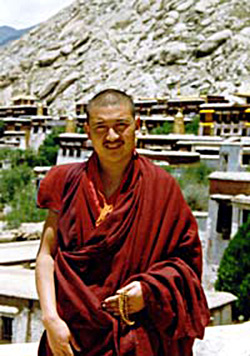
A monk of Samlo Regional House (Samlo Khangtsen), Sera-Tibet.
Like most Tibetan monasteries, Sera has always been a crossroads for a variety of people from different walks of life. First and foremost, of course, it is home to a large population of resident monks (drapa).[1] Before 1959, monks came to the monastery from different parts of Tibet, but also from Mongolia and Bhutan, and from several Tibetan-speaking Indian border-regions, like Ladakh and Mön (presently part of the state of Arunachal Pradesh, India). There are even a few cases of Europeans and Japanese living and studying at Sera.[2] Although foreigners are no longer allowed to live at Sera-Tibet, Sera-India has had a small population of non-Tibetan monks in residence from the 1980s to the present day. Recently, the Foundation for the Preservation of the Mahayana Tradition (FPMT) has even inaugurated a residence for foreign monks at Sera-India, called Shedrup Zungdrel Ling, “The Place for Combining Study and Practice.” But the overwhelming majority of monks at Sera were, and continue to be, ethnic Tibetans.
Of course, on a daily basis there are many non-monks that can be found within the perimeter walls of the monastery (in both India and in Tibet). In Tibet, for example, pilgrims (nekhorkhen) from all over the Tibetan cultural sphere (and increasingly from non-Tibetan regions of China, and from abroad) will find their way through the monastery’s gates. Sera-India attracts pilgrims chiefly from the refugee Tibetan population, but it has also become a pilgrimage site for the non-Tibetan students of senior Sera monks who have founded centers abroad.
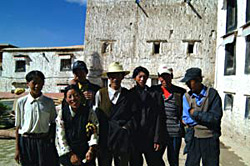
Pilgrims from the Penpo region of Tibet pose for a picture in Sera, Tibet.
As the closest to Lhasa of the three large Gelukpa academies, with over two-dozen temples in the space of a single square kilometer, Sera-Tibet is also popular with local lay worshippers (chönjel dronkhen) from the capital and surrounding areas. These individuals will often come to spend the day at Sera, where they make offerings in temples, request prayers and rituals, visit monk acquaintances and relatives, and have lunch under the trees behind Sera’s restaurant. Sera-India maintains this same type of close relationship with lay Tibetan in the nearby settlement camps.
In recent years, Lhasa school children (lopdruk) come to the monastery on field trips. For them Sera is a place to learn about their cultural heritage. In India, groups of school children – both Tibetan and Indian – visit the monastery on a regular basis. And for some years now Sera, in both India and in Tibet, has been a popular stop for groups of foreign students who are part of education-abroad programs.
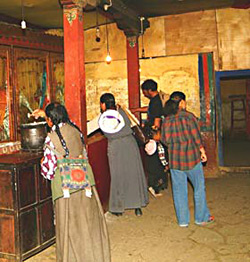 Local worshippers make butter offerings into the butter-lamps in a chapel of one of Sera’s regional houses (Sera-Tibet). |
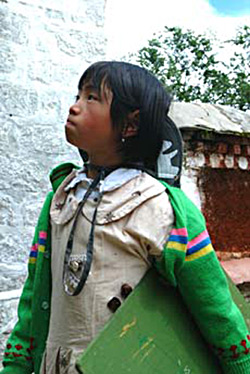 A young Tibetan girl, art supplies in hand, about to enter one of Sera’s temples in Tibet. |
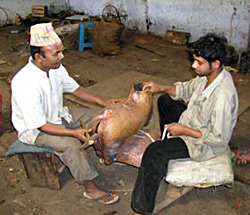
Nepali metalworkers, who live in the monastery, creating a statue in Sera-India.
Even before 1959 some lay people lived within the monastery. For example, the residences of some of the more important lamas had special rooms for the lama’s parents. Abbots had young, non-monk workers who would serve as their attendants; they would live in the abbots’ household, and would accompany them as stewards whenever the abbot left his quarters. Laymen contracted for specific work – masons, artists, woodworkers, and construction workers – would often reside within the monastery until their work was completed. The majority of lay workers (for example, the lay kitchen staff), however, lived outside of the monastery. In both India and in Tibet, even today, because of the immense amount of construction and restoration work that needs be done in Tibet, non-monk workers (lechepa) from different parts of the country take up temporary residence in the monastery for short periods of time while in the monastery’s employ. In India, construction workers are usually members of the local Indian and Tibetan communities, and these individuals return to their homes at the end of the day. Because of the dearth of artisans in these communities, however, Tibetan painters and Nepali metal workers will often be brought in for specific projects, residing within the monastery for the duration of their contracted work.
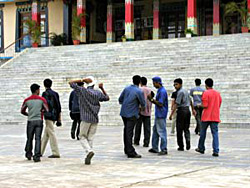
A group of young Indian men visit Sera-India as tourists.
Since the opening of Tibet to foreign tourism in the 1980s, Sera has become a site for tourists (dakorwa). Especially during the summer months, busloads of ethnic-Chinese sightseers, and tourists from every corner of the world, visit the monastery on a daily basis. Tourists, of course, are a new addition to the types of people found at Sera, unknown in its history until the last two decades. In Tibet, the monastery survives in part from the revenues of tourism, charging foreigners a hefty admission fee. Sera-India is also increasingly becoming a tourist venue. It is now found in some of the tourist guidebooks of south India. Increasingly, Indian tourists come to Sera in large numbers.
Finally, and most recently, Sera has become the site for the Sera Project. In Tibet this has brought to the monastery a team of scholars and research assistants from the Universities of California and Virginia, and from the Tibet Academy of Social Sciences. Researchers (zhimjuk chekhen) are of course different from tourists and pilgrims, falling in a category all their own, but we too are today a part of the Sera landscape.
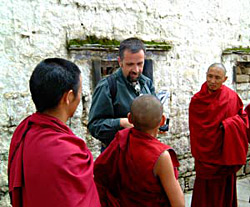
José I. Cabezón, the director of the Sera Project, interviews monks in Sera, Tibet, 2002.
Many different kinds people, therefore, can be found at Sera on any given day. They come to the monastery from different places, and with different goals and motivations. By Tibetan standards, Sera has always been relatively cosmopolitan. And globalization is making it increasingly more so.
In this portion of the Sera Project website, you will learn about all of these various kinds of people. Another portion of the “People” section – presently under construction, will allow you to learn more about some of the more important figures in Sera’s history: its famous lamas, abbots, and geshés. In the sections that follow, though, our emphasis has been on giving you a sense of the types of people who lived in the monastery, and those who visited it.
Click on the various links in the side menu to learn more about that particular group:
- Monks
- Pilgrims
- Worshippers
- Tourists
Note: The glossary is organized into sections according to the main language of each entry. The first section contains Tibetan words organized in Tibetan alphabetical order. To jump to the entries that begin with a particular Tibetan root letter, click on that letter below. Columns of information for all entries are listed in this order: THL Extended Wylie transliteration of the term, THL Phonetic rendering of the term, the English translation, the Sanskrit equivalent, associated dates, and the type of term. To view the glossary sorted by any one of these rubrics, click on the corresponding label (such as “Phonetics”) at the top of its column.
| Ka | |||||
| Extended Wylie | Phonetics | English | Sanskrit | Date | Type |
|---|---|---|---|---|---|
| kong po khang tshan | Kongpo Khangtsen | Kongpo Regional House | Monastery | ||
| bka’ ’gyur | Kangyur | translated words of the Buddha, the Tibetan Buddhist canon | Title collection | ||
| bkra shis tshe ring | Trashi Tsering | Tashi Tsering | Person | ||
| sku zhabs | kuzhap | reverend | Term | ||
| skyid sdug | kyiduk | a monk officially “on the books” | Term | ||
| Kha | |||||
| Extended Wylie | Phonetics | English | Sanskrit | Date | Type |
| khang tshan | khangtsen | regional house | Term | ||
| khang tshan gyi bla ma | khangtsengyi lama | lama of the regional house | Term | ||
| khang tshan dge rgan | khangtsen gegen | regional house “teacher” | Term | ||
| khams | Kham | Place | |||
| khungs | khung | organizational affiliation | Term | ||
| khri zur lhun grub brtson ’grus | Trizur Lhündrup Tsöndrü | Person | |||
| mkhan po | khenpo | abbot | Term | ||
| mkhan zur blo bzang tshe ring | Khenzur Lopsang Tsering | Person | |||
| mkhan rin po che blo bzang don yod | Khen Rinpoché Lopsang Dönyö | Person | |||
| Ga | |||||
| Extended Wylie | Phonetics | English | Sanskrit | Date | Type |
| go sa | gosa | status | Term | ||
| grwa | dra | monk | Term | ||
| grwa rgyun | dragyün | continuing monks | Term | ||
| grwa pa | drapa | monk | Term | ||
| grwa pa dkyus ma | drapa kyüma | ordinary monk | Term | ||
| grwa tshang | dratsang | college | Term | ||
| grwa tshang gi bla ma | dratsanggi lama | lama of the college | Term | ||
| grwa tshang stod pa | Dratsang Töpa | Töpa College | Monastery | ||
| grwa tshang byes | Dratsang Jé | Jé College | Monastery | ||
| grwa tshang smad | Dratsang Mé | Mé College | Monastery | ||
| grwa log | dralok | monks who leave the monkhood | Term | ||
| gling ka | lingka | fraternal unit of dopdops; park | Term | ||
| gling gseb | lingsep | a geshé degree granted jointly by Sera’s two philosophical colleges | Term | ||
| dga’ ldan | Ganden | Monastery | |||
| dga’ ldan khri pa | Ganden Tripa | Throne Holder of Ganden | Term | ||
| dge bkod | gekö | disciplinarian | Term | ||
| dge snyen | genyen | the five basic vows of a layman | upāsaka | Term | |
| dge ’dun lhag ma bcu gsum | gendün lhakma chuksum | thirteen community-residue | Term | ||
| dge tshul | getsül | novice | Term | ||
| dge lugs | Geluk | Organization | |||
| dge bshes | geshé | Term | |||
| dge bshes bstan dar | Geshé Tendar | Person | |||
| dge bshes bzod pa | Geshé Zöpa | Geshe Sopa | Author | ||
| dge bshes ye shes dbang phyug | Geshé Yeshé Wangchuk | Author | |||
| dge bshes rab brtan | Geshé Rapten | Geshe Rabten | Person | ||
| dge bshes lha ram pa | geshé lharampa | a geshé degree granted by the Tibetan government in public examinations | Term | ||
| dge bshes lhun grub thabs mkhas | Geshé Lhündrup Tapkhé | Person | |||
| dge slong | gelong | fully ordained monk | Term | ||
| dge slong ma | gelongma | fully ordained nun | Term | ||
| dgong bcad | gongché | a monastic who fasts in the evening | Term | ||
| ’gyed | gyé | monetary donations (for the monastic assembly) | Term | ||
| ’grel pa | drelpa | commentary | Term | ||
| rgan byams pa | Gen Jampa | Person | |||
| rgyal sprul ho thog thu | Gyeltrül Hotoktu | incarnation of a previous king/regent | Term | ||
| sgo gnyer | gonyer | door keeper, temple attendant | Term | ||
| sgrigs zhugs | drikzhuk | official membership | Term | ||
| Nga | |||||
| Extended Wylie | Phonetics | English | Sanskrit | Date | Type |
| ngag dbang gsung rab mthu stobs | Ngawang Sungrap Tutop | 1874-1952 | Person | ||
| nges ’byung | ngenjung | renunciation | Term | ||
| sngags pa | Ngakpa | Tantric College, Ngakpa College | Monastery | ||
| sngags pa grwa tshang | Ngakpa Dratsang | Tantric College, Ngakpa College | Monastery | ||
| Cha | |||||
| Extended Wylie | Phonetics | English | Sanskrit | Date | Type |
| chab ril | chapril | water bearers, assembly monitors | Term | ||
| chen mo lags | chenmolak | great one, chant master | Term | ||
| chos mdzad | chöndzé | religious devotee | Term | ||
| chos gzhi | chözhi | endowment | Term | ||
| mchod mjal ’gro mkhan | chönjel dronkhen | worshipper | Term | ||
| Ja | |||||
| Extended Wylie | Phonetics | English | Sanskrit | Date | Type |
| ja ma | jama | tea master | Term | ||
| ’jang dgun chos | jang günchö | winter logic debate | Term | ||
| Nya | |||||
| Extended Wylie | Phonetics | English | Sanskrit | Date | Type |
| gnyer tshang | nyertsang | keeper of the stores | Term | ||
| Ta | |||||
| Extended Wylie | Phonetics | English | Sanskrit | Date | Type |
| tre hor | Trehor | Trehor Regional House | Place | ||
| lta skor ba | takorwa | tourist | Term | ||
| stag brag khri sprul | Takdrak Tritrül | Takdrak Rinpoché | 1874-1952 | Person | |
| stod pa | Töpa | Töpa College | Monastery | ||
| bstan ’gyur | Tengyur | the commentarial portion of the Tibetan Buddhist canon | Title collection | ||
| Tha | |||||
| Extended Wylie | Phonetics | English | Sanskrit | Date | Type |
| thang ka | tangka | scroll painting | Term | ||
| thub bstan ’jam dpal ye shes bstan pa’i rgyal mtshan | Tupten Jampel Yeshé Tenpé Gyeltsen | d. 1947 | Person | ||
| Da | |||||
| Extended Wylie | Phonetics | English | Sanskrit | Date | Type |
| dung dkar rin po che | Dungkar Rinpoché | Author | |||
| dwags po | Dakpo | Place | |||
| drung yig | drungyik | college secretary | Term | ||
| gdan sa | densa | great seat | Term | ||
| ’dul ba | Dülwa | the corpus of monastic rules | vinaya | Doxographical Category | |
| rdo rams pa | dorampa | a geshé degree granted by Drepung Monastery | Term | ||
| ldob ldob | dopdop | punk monk, worker monk | Term | ||
| sde dge | Degé | Organization | |||
| sde gnod | denö | major subdivision of the Buddhist canon | piṭaka | Title collection | |
| sde srid sang rgyas rgya mtsho | Desi Sanggyé Gyatso | Author | |||
| sdom pa | dompa | formal vows | Term | ||
| Na | |||||
| Extended Wylie | Phonetics | English | Sanskrit | Date | Type |
| nor bu gling kha | Norbu Lingkha | Building | |||
| gnas ’khor mkhan | nekhorkhen | pilgrim | Term | ||
| Pa | |||||
| Extended Wylie | Phonetics | English | Sanskrit | Date | Type |
| pe cin | Pechin | Beijing | Publication Place | ||
| po ta la | Potala | Building | |||
| dpe cha ba | pechawa | textualist | Term | ||
| spyi rgan | chigen | chief elder | Term | ||
| spyi pa | chipa | financial officer | Term | ||
| spyi gso | chiso | provost, “caretaker of (the monks) in general” | Term | ||
| sprul sku | trülku | recognized incarnation | Term | ||
| Pha | |||||
| Extended Wylie | Phonetics | English | Sanskrit | Date | Type |
| pham pa | pampa | the four defeats | Term | ||
| phyag mdzod | chandzö | treasurer | Term | ||
| ’phan po | Penpo | Place | |||
| Ba | |||||
| Extended Wylie | Phonetics | English | Sanskrit | Date | Type |
| bai ḍūrya ser po | Baidurya Serpo | Text | |||
| byang | Chang | Place | |||
| byams chen chos rje | Jamchen Chöjé | 1354-1435 | Person | ||
| byams smon sgrub mchod | Jammön Drupchö | Maitreya Prayer/Offering Festival | Festival | ||
| byes | Jé | Jé College | Monastery | ||
| bla kha bcu | Lakha Chu | Council of Ten Lamas | Term | ||
| bla spyi | lachi | lama society | Term | ||
| bla brang | labrang | a lama’s household | Term | ||
| bla ma | lama | anyone who serves as the spiritual mentor of anyone else, recognized incarnation | guru | Term | |
| bla ma cung khag | lama chungkhak | “small” lama | Term | ||
| bla ma che khag | lama chekhak | “great” lama | Term | ||
| bla ma ’bring khag | lama dringkhak | “medium” lama | Term | ||
| dbu mdzad | umdzé | leader, chant master | Term | ||
| dbyar chos pa | yarchöpa | summer session staff | Term | ||
| ’bras spungs | Drepung | Monastery | |||
| Ma | |||||
| Extended Wylie | Phonetics | English | Sanskrit | Date | Type |
| mi rigs dpe skrun khang | Mirik Petrünkhang | Nationalities Publishing House | Publisher | ||
| mon | Mön | Place | |||
| dmigs gsal | miksel | special, exceptional treatment | Term | ||
| smad | Mé | Mé College | Monastery | ||
| smon lam chen mo | Mönlam Chenmo | Great Prayer Festival | Festival | ||
| tsa | |||||
| Extended Wylie | Phonetics | English | Sanskrit | Date | Type |
| tsong kha pa | Tsongkhapa | Person | |||
| gtsang pa khang tshan | Tsangpa Khangtsen | Tsangpa Regional House | Monastery | ||
| brtsi bzhag | tsizhak | accounting | Term | ||
| brtson ’grus | tsöndrü | will, diligence | Term | ||
| Tsha | |||||
| Extended Wylie | Phonetics | English | Sanskrit | Date | Type |
| tshe dbang rin chen | Tsewang Rinchen | Editor | |||
| tshe smon gling | Tsemönling | Monastery | |||
| tshogs chen | Tsokchen | Great Assembly Hall | Building | ||
| tshogs chen gyi bla ma | tsokchengyi lama | lama of the Great Assembly | Term | ||
| tshogs gtam chen mo | tsoktam chenmo | The Great Exhortation | Term | ||
| tshogs ’du | tsokdu | board of governance | Term | ||
| tshogs ram | tsokram | a geshé degree granted by the Tibetan government in public examinations | Term | ||
| Zha | |||||
| Extended Wylie | Phonetics | English | Sanskrit | Date | Type |
| zhal ngo | zhelngo | lieutenant | Term | ||
| zhib ’jug byed mkhan | zhimjuk jenkhen | researcher | Term | ||
| gzhi dgon | zhigön | home monastery | Monastery | ||
| Za | |||||
| Extended Wylie | Phonetics | English | Sanskrit | Date | Type |
| gzims khang sde pa | zimkhang depa | representative to the Tibetan government; “government official in charge of the rooms” | Term | ||
| Ya | |||||
| Extended Wylie | Phonetics | English | Sanskrit | Date | Type |
| yang srid | yangsi | recognized incarnation | Term | ||
| yig cha | yikcha | textbook | Term | ||
| yongs ’dzin | yongdzin | live-in tutor | Term | ||
| Ra | |||||
| Extended Wylie | Phonetics | English | Sanskrit | Date | Type |
| rab tu byung | raptujung | monk | Term | ||
| rab byung | rapjung | renunciate | Term | ||
| rig pa | rikpa | intellect | Term | ||
| rig pa chung chung | rikpa chungchung | little by way of intelligence | Term | ||
| rig pa mi ’dug | rikpa minduk | no intelligence at all | Term | ||
| rigs che chung tshogs langs | rik chechung tsoklang | Lesser and Greater Lineage Debuts | Term | ||
| rigs ram | rikram | a geshé degree granted internally by one of Sera’s two philosophical colleges | Term | ||
| rigs ram pa | rikrampa | a geshé degree granted internally by one of Sera’s two philosophical colleges | Term | ||
| rol dbyangs pa | rölyangpa | musician | Term | ||
| rwa sgreng | Radreng | Monastery | |||
| rwa sgreng rin po che | Radreng Rinpoché | Reting Rinpoché | Person | ||
| rwa sgreng rin po che sku phreng lnga pa | Radreng Rinpoché Kutreng Ngapa | the Fifth Radreng Rinpoché | d. 1947 | Person | |
| La | |||||
| Extended Wylie | Phonetics | English | Sanskrit | Date | Type |
| las | lé | ritual action | Term | ||
| las sne pa | lenepa | administrator | Term | ||
| las byed pa | lejepa | worker | Term | ||
| lo gsar | Losar | New Year Festival | Festival | ||
| log | lok | to return, toturn away from; a mistake | Term | ||
| Sha | |||||
| Extended Wylie | Phonetics | English | Sanskrit | Date | Type |
| shag | shak | household | Term | ||
| shag chas | shakché | monk’s share (of the estate) | Term | ||
| shag tshan | shaktsen | household | Term | ||
| shar pa sprul sku | Sharpa Trülku | Person | |||
| shar pa bla brang | Sharpa Labrang | Organization | |||
| bshad sgrub zung ’brel gling | Shedrup Zungdrel Ling | The Place for Combining Study and Practice | Place | ||
| Sa | |||||
| Extended Wylie | Phonetics | English | Sanskrit | Date | Type |
| se ra | Sera | Monastery | |||
| se ra khri pa | Sera Tripa | Sera Throne Holder | Term | ||
| se ra theg chen gling | Sera Tekchen Ling | Text | |||
| ser smad thos bsam nor bu gling grwa tshang gi chos ’byung lo rgyus nor bu’i phreng ba | Sermé Tösam Norbuling Dratsanggi Chöjung Logyü Norbü Trengga | Text | |||
| ser smad dpe mdzod khang | Sermé Pendzökhang | Publisher | |||
| slob phrug | lopdruk | school children | Term | ||
| gso sbyong | sojong | purification/confession ritual | Term | ||
| bsam blo khang tshan | Samlo Khangtsen | Samlo Regional House | Place | ||
| Ha | |||||
| Extended Wylie | Phonetics | English | Sanskrit | Date | Type |
| har gdong khang tshan | Hamdong Khangtsen | Hamdong Regional House | Place | ||
| lha bris pa | lhapripa | painter | Term | ||
| lha bzo ba | lhapzowa | sculpter | Term | ||
| lha ram | lharam | a geshé degree granted by the Tibetan government in public examinations | Term | ||
| lha sa | Lhasa | Place | |||
| A | |||||
| Extended Wylie | Phonetics | English | Sanskrit | Date | Type |
| a mdo | Amdo | Place | |||
| a ni | ani | nun | Term | ||
| Sanskrit | |||||
| Extended Wylie | Phonetics | English | Sanskrit | Date | Type |
| gandhara | Place | ||||
| the Jé College tutelary deity | hayagrīva | Buddhist deity | |||
| the vinaya which Chinese Buddhists follow | mahāsāṃghika vinaya | Doxographical Category | |||
| the vinaya which Tibetan Buddhists follow | mūlasarvāstivāda vinaya | Doxographical Category | |||
| a commentary on the vinaya | nidāna | Doxographical Category | |||
| lasting happiness, permanent peace | nirvāṇa | Term | |||
| a text containing the Theravāda Buddhist vows | patimokkha | Text | |||
| ascetic | śramaṇa | Term | |||
| a type of Buddhism practiced in most of Southeast Asia | theravāda | Doxographical Category | |||
| the vinaya which Theravāda Buddhists follow | theravāda vinaya | Doxographical Category | |||
| a commentary on the vinaya found in the Tengyur | vinayasūtra | Text | |||
| the first text of the vinaya | vinayavastu | Text | |||
[1] In Lhasa especially there was a more “polite” term used for monks, kuzhap. But in the great monastic academies, the term kuzhap was reserved for recognized incarnations (trülku) also called lamas.
[2] For example, we know that the Italian Catholic missionary Ippolito Desideri (1684-1732) lived and studied at Sera for a short time, and that the Zen monk Kawaguchi Ekai also lived at Sera in the early part of the twentieth century.